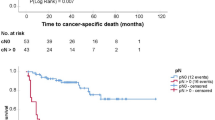Abstract
Purpose
To determine whether the number of lymph nodes (LNs) examined is associated with outcomes in patients without nodal metastasis after radical cystectomy (RC).
Patients and Methods
We retrospectively analyzed data from 4,188 patients treated at 12 centers with RC and pelvic lymphadenectomy without neo-adjuvant chemotherapy for urothelial carcinoma of the bladder (UCB). Outcomes of patients without LN metastasis (n = 3,088) were examined according to the LN yield analyzed as continuous variable, tertiles, and using the cutoffs of ≥9 and ≥20.
Results
The median nodal yield was 18 (range 1–123; IQR:20). A total of 2591 (84 %) and 1445 (47 %) patients had a LN yield ≥9 and ≥20, respectively. Median follow-up was 47 months (IQR:70). In multivariable analyses that adjusted for the standard clinicopathologic factors, higher LN yield was associated with a decreased risk of disease recurrence (continuous: HR = 0.996, p = 0.05; 3rd vs 1st tertile: HR = 0.853, p = 0.048; cutoff ≥20: HR = 0.851, p = 0.032). In the subgroups of patients with muscle-invasive UCB or those with ≥9 LN removed, LN yield was not associated with outcomes (p values >0.05).
Conclusions
In this large multicenter cohort of patients with node-negative UCB, higher nodal yield improved recurrence-free survival when all patients were analyzed. Patients with a high LN yield (≥20 LN removed or 3rd tertile) had the largest benefit. The lack of prognostic significance of LN yield in patients with muscle-invasive UCB or those stratified by 9 LNs removed suggests that this effect is weak. Further prospective studies are needed to help identify preoperatively the optimal template for each patient.

Similar content being viewed by others
References
Shariat SF, Karakiewicz PI, Palapattu GS et al (2006) Outcomes of radical cystectomy for transitional cell carcinoma of the bladder: a contemporary series from the Bladder Cancer Research Consortium. J Urol 176:2414–2422 (discussion 2422)
Stein JP, Lieskovsky G, Cote R et al (2001) Radical cystectomy in the treatment of invasive bladder cancer: long-term results in 1,054 patients. J Clin Oncol 19:666–675
Herr H, Lee C, Chang S, Lerner S (2004) Standardization of radical cystectomy and pelvic lymph node dissection for bladder cancer: a collaborative group report. J Urol 171:1823–1828 (discussion 1827–1828)
Mathiesen O, Carl J, Bonderup O, Panduro J (1990) Axillary sampling and the risk of erroneous staging of breast cancer. An analysis of 960 consecutive patients. Acta Oncol 29:721–725
Siewert JR, Bottcher K, Stein HJ, Roder JD (1998) Relevant prognostic factors in gastric cancer: ten-year results of the German Gastric Cancer Study. Ann Surg 228:449–461
Caplin S, Cerottini JP, Bosman FT, Constanda MT, Givel JC (1998) For patients with Dukes’B (TNM Stage II) colorectal carcinoma, examination of six or fewer lymph nodes is related to poor prognosis. Cancer 83:666–672
Leissner J, Ghoneim MA, Abol-Enein H et al (2004) Extended radical lymphadenectomy in patients with urothelial bladder cancer: results of a prospective multicenter study. J Urol 171:139–144
May M, Herrmann E, Bolenz C et al (2011) Association between the number of dissected lymph nodes during pelvic lymphadenectomy and cancer-specific survival in patients with lymph node-negative urothelial carcinoma of the bladder undergoing radical cystectomy. Ann Surg Oncol 18:2018–2025
Herr HW, Bochner BH, Dalbagni G et al (2002) Impact of the number of lymph nodes retrieved on outcome in patients with muscle invasive bladder cancer. J Urol 167:1295–1298
Koppie TM, Vickers AJ, Vora K, Dalbagni G, Bochner BH (2006) Standardization of pelvic lymphadenectomy performed at radical cystectomy: can we establish a minimum number of lymph nodes that should be removed? Cancer 107:2368–2374
Leissner J, Hohenfellner R, Thuroff JW, Wolf HK (2000) Lymphadenectomy in patients with transitional cell carcinoma of the urinary bladder; significance for staging and prognosis. BJU Int 85:817–823
Poulsen AL, Horn T, Steven K (1998) Radical cystectomy: extending the limits of pelvic lymph node dissection improves survival for patients with bladder cancer confined to the bladder wall. J Urol 160:2015–2019 (discussion 2020)
Shirotake S, Kikuchi E, Matsumoto K et al (2010) Role of pelvic lymph node dissection in lymph node-negative patients with invasive bladder cancer. Jpn J Clin Oncol 40:247–251
Shariat SF, Karakiewicz PI, Palapattu GS et al (2006) Nomograms provide improved accuracy for predicting survival after radical cystectomy. Clin Cancer Res 12:6663–6676
Rink M, Fajkovic H, Cha EK et al (2012) Death certificates are valid for the determination of cause of death in patients with upper and lower tract urothelial carcinoma. Eur Urol 61:854–855
Weingartner K, Ramaswamy A, Bittinger A et al (1996) Anatomical basis for pelvic lymphadenectomy in prostate cancer: results of an autopsy study and implications for the clinic. J Urol 156:1969–1971
Dorin RP, Skinner EC (2010) Extended lymphadenectomy in bladder cancer. Curr Opin Urol 20:414–420
Fang AC, Ahmad AE, Whitson JM et al (2010) Effect of a minimum lymph node policy in radical cystectomy and pelvic lymphadenectomy on lymph node yields, lymph node positivity rates, lymph node density, and survivorship in patients with bladder cancer. Cancer 116:1901–1908
Karl A, Carroll PR, Gschwend JE et al (2009) The impact of lymphadenectomy and lymph node metastasis on the outcomes of radical cystectomy for bladder cancer. Eur Urol 55:826–835
Kurahashi T, Hara I, Oka N et al (2005) Detection of micrometastases in pelvic lymph nodes in patients undergoing radical cystectomy for locally invasive bladder cancer by real-time reverse transcriptase-PCR or cytokeratin 19 and uroplakin II. Clin Cancer Res 11:3773–3777
Roth B, Wissmeyer MP, Zehnder P et al (2010) A new multimodality technique accurately maps the primary lymphatic landing sites of the bladder. Eur Urol 57:205–211
Konety BR, Joslyn SA, O’Donnell MA (2003) Extent of pelvic lymphadenectomy and its impact on outcome in patients diagnosed with bladder cancer: analysis of data from the surveillance, epidemiology and end results program data base. J Urol 169:946–950
Heck MM, Gschwend JE, Retz M (2010) Update on chemotherapy for bladder cancer. Update 2010. Urologe A 49:1294–1300
Shariat SF, Roudier MP, Wilcox GE et al (2003) Comparison of immunohistochemistry with reverse transcription-PCR for the detection of micrometastatic prostate cancer in lymph nodes. Cancer Res 63:4662–4670
Vazina A, Dugi D, Shariat SF et al (2004) Stage specific lymph node metastasis mapping in radical cystectomy specimens. J Urol 171:1830–1834
Acknowledgments
Dr. Michael Rink is supported by The Frederick J. and Theresa Dow Wallace Fund of the New York Community Trust.
Conflict of interest
Dr. S.F. Shariat is advisory board member for Ferring Pharma. All other authors have no conflict of interest to disclose.
Author information
Authors and Affiliations
Corresponding authors
Additional information
Michael Rink and Shahrokh F. Shariat equally contributed to this manuscript.
Rights and permissions
About this article
Cite this article
Rink, M., Shariat, S.F., Xylinas, E. et al. Does increasing the nodal yield improve outcomes in patients without nodal metastasis at radical cystectomy?. World J Urol 30, 807–814 (2012). https://doi.org/10.1007/s00345-012-0910-5
Received:
Accepted:
Published:
Issue Date:
DOI: https://doi.org/10.1007/s00345-012-0910-5




